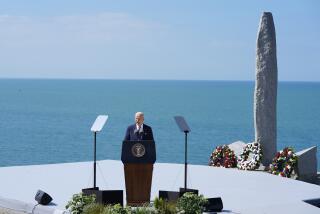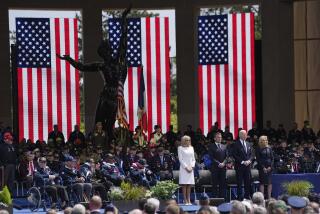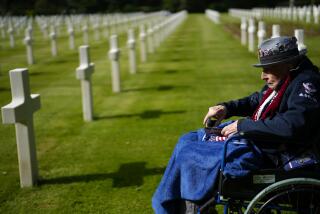Putting D-Day in Focus
- Share via
George Hjorth’s orders that June morning 54 years ago were mysterious: After parachuting into occupied France with his three cameras, he was to hide in front of the German lines at Normandy and photograph whatever happened on the beach.
It was before dawn on June 6, 1944, and Hjorth was in the dark, literally and figuratively. He had no idea of what to expect on that now-fabled stretch of coastline.
Only when the invasion began did he learn that his mission was to film the D-day landing of the U.S Army’s 1st Infantry Division and the 29th Infantry Division at Omaha Beach--from the German side.
But whatever he saw, Hjorth (pronounced “Yorth”) was under standing orders not to discuss it for 50 years. Even today, the Cypress retiree’s mission remains an enigma: the film he shot, called unique by historians who recently learned of it from declassified documents, is missing.
“We’re hunting it down,” said Douglas Brinkley, a professor of history and director of the University of New Orleans’ Eisenhower Center. Hjorth’s movie footage and photographs--probably gathering dust in a government archive--are the only known invasion pictures from the German perspective shot at the Normandy beaches, he said.
And recovering the film is important because “it shows how [Gen. Dwight D.] Eisenhower and the OSS saw the important need to capture on film what they knew would be the greatest invasion ever,” Brinkley said.
A Hollywood actor before the war, Hjorth became a combat photographer with the Office of Strategic Services--the forerunner of the CIA--when he enlisted after Pearl Harbor. He was part of a secret unit of filmmakers headed by director John Ford that only in recent years has become public.
Hjorth had parachuted into France three nights before D-day. The night before the invasion he was led to his hiding place on the beach by members of the French Resistance. Hjorth hunkered down with his cameras, about 50 yards from shore, and waited for dawn.
“I could hear the waves, but couldn’t see anything. Then it started getting light, and I saw large dots out in the water. I told myself, ‘Those aren’t islands. Those are ships!’ I realized that I was right in the middle of the invasion of Europe,” he said in a recent interview in his Cypress home.
Hjorth could hear the fire above him from the Germans defending the beach from the American assault. He could feel the concussions as U.S. naval shells exploded around the German bunkers and trench lines. He estimates that he saw as many as 400 Americans die on the beach that day--”a horrible nightmare,” he remembers.
Film ‘Top Secret’
Hjorth, 77 and a retired McDonnell Douglas executive, never saw the film he shot on D-day. A few days after photographing the invasion, he was thrown out of a screening room by an Army lieutenant who declared the film top secret and threatened to court-martial him if he viewed it, he said.
Details of Hjorth’s exploits were revealed this year when the government began declassifying OSS files. The declassified records also revealed new information about Ford’s band of filmmakers and their work for the OSS.
But Hjorth did not consider himself a spy. Instead, he likens himself to “thousands of other guys who went away to fight for our country.”
Upon volunteering for the OSS, Hjorth had to sign an agreement that prevented him from talking about his wartime activities for 50 years. Today, Hjorth talks about his wartime work only with reluctance.
He agreed to recall his D-day exploits only after news accounts reported that amateur military historians who have worked with Brinkley were attempting to locate Hjorth’s D-day film.
Melvin Paisley, a World War II fighter pilot and former assistant secretary of the Navy, said Lars Andersen and he have been combing the National Archives for Hjorth’s footage.
“It’s important because it’s such a unique situation. Until the records were declassified, we didn’t know that OSS photographers like Hjorth were actually dropped behind enemy lines,” Paisley said. “Nobody knew about it because the men who did it weren’t allowed to talk about it. . . . But now that we know about Hjorth’s film, you can bet we’re going to find it.”
Hjorth said he is proud of the work he did for the OSS but prefers to forget about the war.
“I’ve put the war behind me. I prefer to recall happy moments. I’m the eternal optimist. I filmed too many terrible scenes that provoke sadness whenever I think about them,” he said.
Among the scenes Hjorth would prefer to forget are pictures of the Buchenwald death camp and film he shot of another Nazi atrocity in France, where he photographed the corpses of dozens of civilians who were trapped in an underpass and burned alive. As an OSS photographer he was called upon to document these scenes as seen by liberating American forces.
Although it has been more than half-a-century since he witnessed these events, talking about them still drives him to tears.
“I still can’t take it,” he said. “It’s one thing to photograph a battle from a distance, but when you have to photograph something so terrible up close, it’s awful. . . . I still remember two of the victims burned alive in the underpass by the Nazis; a woman who was clutching her baby to her breast, both terribly burned.”
Hometown Hollywood
Until the war began, life had been one pleasant memory after another for Hjorth.
He grew up in Hollywood, where his father owned a restaurant at Las Palmas Avenue and Hollywood Boulevard. Sid Grauman, owner of the nearby Egyptian Theater, was a frequent diner.
According to Hjorth, Grauman encouraged his parents to “register me with central casting,” and he began getting small parts in movies when he was 3. He had already appeared in several films when World War II began.
One wall of his home is lined with Hollywood publicity shots of movies where he appeared with Don Ameche, Lionel Barrymore, Tom Mix, a young Jackie Cooper and others stars.
After the Japanese attack on Pearl Harbor, Hjorth said he decided to enlist in the Army Air Force but a friend at Paramount suggested that he volunteer for Ford’s military movie crew instead.
His hobby was photography, and that was enough to qualify him for membership in Ford’s unit. He became one of the original 17 movie makers assigned to Ford’s outfit, he said.
Hjorth said his first combat assignment was to photograph the Allies’ 1943 invasion of North Africa, including several ground battles, followed by documenting the U.S. landings in Sicily and Italy.
Following the Italian campaign, Hjorth was sent to airborne school to prepare him for the nine jumps he made into Nazi-occupied France and Germany before D-day, he said.
“Not all of my assignments were to film battles. My jumps into France and Germany were to take pictures of bridges, roads, rivers, railroads and even a V-1 [rocket] launch site,” said Hjorth.
According to Hjorth, Resistance fighters took him to within 100 feet of a V-1 site, and his film provided valuable intelligence to Allied planners, who were trying to find ways to defeat the rocket “buzz” bombs that the Germans aimed at London.
Hjorth, who would usually parachute into enemy occupied territory without a weapon, was always met on the ground by Resistance fighters who would take him to the targets he was suppose to film.
After completing his missions, Hjorth said he was usually extracted by airplane. Twice he was met by a submarine and once by a Navy destroyer, he said.
Hjorth kept few mementos of his days in the OSS. Forbidden to talk about his wartime exploits, he said that whenever he was asked what did in World War II, he would say simply, “Oh, I took pictures.”
(BEGIN TEXT OF INFOBOX / INFOGRAPHIC)
The Battles of Hjorth
Movie-maker George Hjorth received five battle stars for the World War II combat footage he captured during Allied military offensives, including the D-day landing at Omaha Beach.
Oran
Nov. 9-Dec. 23, 1942
Went ashore with troops during invasion of North Africa
Algiers
Nov. 11, 1942
Photographed troops landing, ensuing battle
Omaha Beach
June 6-20, 1944
Parachuted behind enemy lines three days before invasion of Normandy, filmed Allied troops storming beach
Le Harve
Aug. 23-25, 1944
Filmed Allied planes bombing shore, ships shelling beach
Marseilles
Sept. 10-12, 1944
Documented beginning of Rhone Valley invasion
Filming Behind Enemy Lines
Hjorth made nine jumps into Nazi territory during the height of World War II to take reconnaissance photos and film footage of key military targets. How he got in and out of enemy territory:
Small plane flies below radar
ARRIVAL
1) Hjorth parachutes in with cameras, film strapped to his body
Hand signs send signal to waiting underground resistance
MISSION
2) Disguised as a German soldier, Hjorth photographs and films bridges, weapons, documents
DEPARTURE
Anchors
Poles
Harness hooked to suspended wire
3) Plane swoops in, hooks wire, carries Hjorth away
Winch reels in Hjorth
Source: George Hjorth
Graphics reporting by BRADY MacDONALD / Los Angeles Times
More to Read
Only good movies
Get the Indie Focus newsletter, Mark Olsen's weekly guide to the world of cinema.
You may occasionally receive promotional content from the Los Angeles Times.









